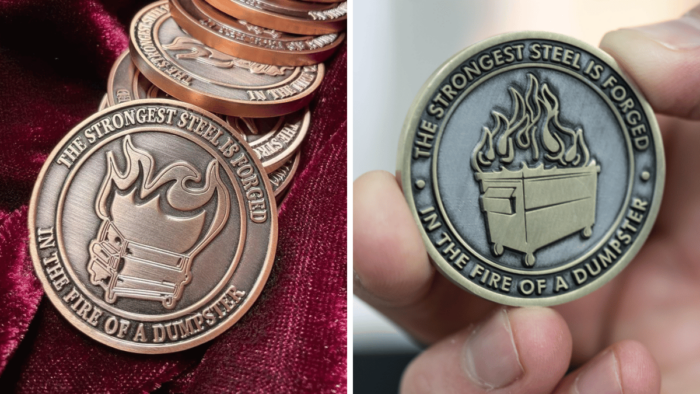A Copyright Fight Over a Dumpster Fire

Over the past two years, the Copyright Claims Board (CCB) has been an endless source of strange and interesting copyright cases.
This list has included flight cockpit recorders, raunchy comedians, tarot decks, printed miniatures, and much more.
However, some recently filed cases may have reached a new height in bizarreness.
Though copyright law is often called a dumpster fire, this is likely the first fight over a dumpster fire. Or, at least, an image of one.
But while the subject matter is definitely comical, the issues are not. The case raises serious questions about what is and is not protected by copyright. It’s a thorny case for the CCB, but I have no doubt the board can handle it.
Still, it’s worth examining how such a bizarre subject became a heated dispute.
The Battle Over Dumpster Fire Coins

The case pits two makers of challenge coins against one another, Jordan Shaffer and Dave Crim.
Challenge coins have a lengthy history but are more commonly associated with the military and law enforcement in modern times. They are given to commemorate events or accomplishments, such as serving at a particular place or working on a specific project.
However, the market for novelty and collectible challenge coins has grown, with many sellers offering custom, novelty or other types of coins.
One of those sellers is Jordan Shaffer, who sells a variety of such coins on Etsy. One of those coins features a drawing of a dumpster fire with the phrase, “The strongest steel is forged in the fire of a dumpster,” around the edge. The reverse side features a hammer and anvil with the same phrase.
According to evidence provided by Shaffer, Dave Crim bought two such coins in September 2022. Two months after that, according to Shaffer, Crim began selling his own versions of the coin.
Crim’s version of the coin is the same on both sides. Though he used a different drawing of a dumpster fire, he used the same phrase.
This resulted in Shaffer filing takedown notices with Etsy. After those listings were removed, Shaffer moved to Amazon, where he continues to sell today.
That, in turn, brings this case to the CCB.
Dueling Claims, Difficult Issues
The case comes to the CCB in the form of two back-to-back claims. The first, filed by Crim (24-CCB-0173), seeks a judgment of non-infringement. Crim’s case (24-CCB-0174) alleges copyright infringement and seeks damages.
For his part, Crim doesn’t deny the similarities between the coins or that he purchased two of Shaffer’s. Instead, his argument is straightforward: He didn’t copy anything protected by copyright.
According to Crim, the general format of a challenge coin predates Shaffer’s work. Though he admits to using the same phrase, he claims it is a short, common phrase that can’t be protected by copyright. He also argues that his image of a dumpster fire is different and not an infringement.
However, Shaffer argues that Crim’s work is clearly a derivative work and that he has already received a copyright registration from the US Copyright Office. As such, he argues that his coin qualifies for copyright protection and that Crim’s is an unlicensed derivative work.
Unfortunately, Shaffer faces an uphill battle. The reason is simple: He cannot truly own much of his work.
My Analysis
I don’t doubt that Crim likely got the idea from Shaffer’s work. The purchase history makes it irrefutable that he was at least aware of Shaffer’s product before releasing his own.
However, there are three questions that Shaffer has to answer:
- What in his work was original?
- Which of those elements does copyright protect?
- Did Crim copy those protectable elements?
A quick search for the expression finds literally dozens of examples of it being used on other products. You can find it in a similar layout on t-shirts, patches, stickers and more. There’s even another challenge coin maker on Etsy.
Though Shaffer did not say when he first offered his coins, finding evidence of similar works going back to 2020 is trivial. However, it almost certainly goes back much farther than that.
Though the phrase may not be original to Shaffer, the artwork likely is and is protectable. However, Crim didn’t copy the artwork. His art is very different from Shaffer’s.
Shaffer can’t own the idea of a challenge coin or making one with a dumpster fire. Copyright does not protect ideas.
In short, Shaffer is going to have a difficult time making his case. While his specific coin does have copyright protection, there’s not much to stop someone, even a former customer, from making their own coin based on the idea.
Bottom Line
To be clear, I’m very sympathetic toward Shaffer. I don’t think there’s much doubt that Crim bought the coins with the intention of making and selling his own. He took Shaffer’s idea and ran with it. However, he was careful not to use anything protected by copyright.
The law doesn’t offer much recourse here, which is probably good.
After all, it’s almost certain that Shaffer got the idea from somewhere else. Even if he was the first challenge coin maker, a patch maker, t-shirt printer, or sticker company likely gave him the idea for his coin.
Even if he was the first to use this rough design, the phrase and large idea likely predate his use.
There are good reasons why copyright doesn’t protect ideas and short phrases. It would make creating anything impossible.
Still, seeing how the CCB handles this case will be interesting. Overall, the board has done a good job parsing copyright issues.
Regardless, this will be the first time they’ve heard a case dealing with a literal dumpster fire.
Want to Reuse or Republish this Content?
If you want to feature this article in your site, classroom or elsewhere, just let us know! We usually grant permission within 24 hours.
